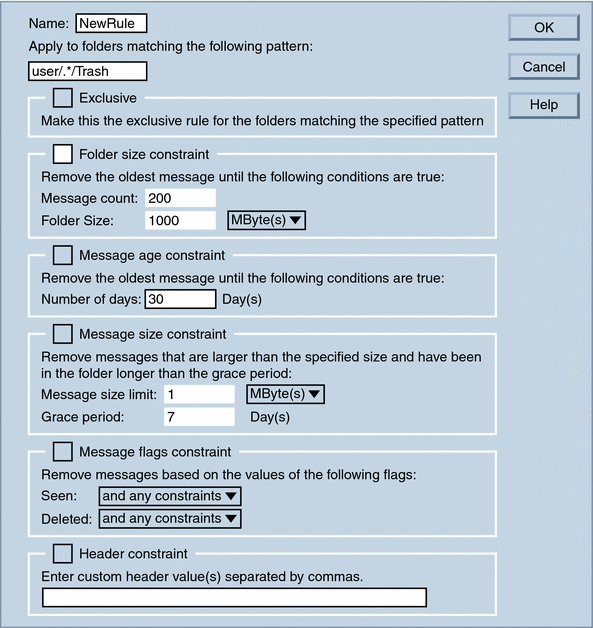 To Set Global Automatic Message Removal Rules with the Console
To Set Global Automatic Message Removal Rules with the Console
Note that while it is possible to set global expiration rules using the Console, using the using store.expirerule is the preferred method. If too many rules are created using the Console or configutil, performance problems can result.
Steps
-
Bring up the automatic message removal GUI as follows:
Main Console > Server Group > Messaging Server (Open) >Messaging Server Console > Configuration Tab > Message Store > Expire/Purge >Add
A very rough drawing of the GUI is shown on Figure 18–4.
Figure 18–4 Automatic Message Removal (Expire/Purge) GUI—Rough Drawing

-
Enter a name for the new rule.
-
Enter the folders from which messages will be automatically removed.
See Setting imexpire Folder Patterns above.
-
If this rule is the exclusive rule for folders matching the specified criteria, then check the Exclusive box.
If this box is checked, then this rule takes precedence over all other rules matching the specified pattern. See Table 18–8 for details on the exclusive checkbox.
-
To create a rule based on folder size, do the following:
-
Check the Folder Size constraint checkbox. In the Message count field, specify the maximum number of messages that will be retained in a folder before the oldest messages are removed. In the Folder size field, specify the maximum folder size, in bytes, before the oldest messages are removed.
-
-
To create a rule based on message age, check the Message age constraint checkbox:
In the Number of days field, specify the age, in days, of how long messages should remain in the folder.
-
To create a rule based on message size:
-
Check the Message size limit constraint checkbox. In the Message size limit field, enter the maximum size of a message allowed in the folder. In the “Grace period” field, enter the how long over-sized messages will remain in the folder before being removed.
-
-
To create a rule based on whether the Seen or Deleted message flags are set:
-
Check the Message flags constraint checkbox.
-
For the Seen: field, select “and” to specify that the message must be seen and another criteria must be met before the rule is fulfilled. Select “or” to specify that the message need only be seen or another criteria be met before the rule is fulfilled.
-
For the Deleted: field, select “and” to specify that the message must be deleted and another criteria must be met before the rule is fulfilled. Select “or” to specify that the message need only be deleted or another criteria be met before the rule is fulfilled.
-
-
To create a rule based on a header fields and their values:
-
Check the Header constraint checkbox.
-
Enter a comma separated list of headers and values in the following format:
header1: value1, header2: value2
Example: Subject: Work at Home!,From: virus@sesta.com
For the header Expires and Expiry-Date, the system will remove the message if their date value is older than the Message age constraint. If multiple expiration header fields are specified, the earliest expiration date will be used. (string).
-
-
Click OK to add the new rule to the Automatic Message Removal list.
- © 2010, Oracle Corporation and/or its affiliates
